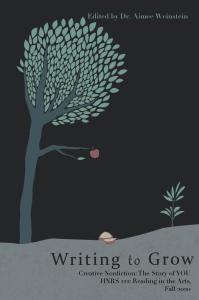Writing to Grow: : Creative Nonfiction, The Story of You, HNRS 122: Reading in the Arts, Fall 2020
Synopsis
One of the gifts of being a writing professor is what I learn from my students as they write. Sometimes when I teach research writing, I have students working on projects in the field of genomics or psychology. Some semesters I get to teach engineers about writing and then I learn about car engines or building hospitals. But this past year, in the midst of a global pandemic, I had the singular experience of teaching not one, but two very special groups of students in the George Mason University Honors College as we engaged in the study and practice of Creative Nonfiction.
Creative Nonfiction is notoriously difficult to define as it’s neither straight-up nonfiction nor true fiction. I tell my students that at its true essence, Creative Nonfiction is story-telling. It has to be true and believable but with elements of surprise and other fiction-esque elements that make it compelling and engaging in its own right. Done well, most people would say that it’s nonfiction that reads like fiction.
During the strange, masked, socially distanced (as best we could) semester of Fall 2020, the two classes had the gift of meeting once a week in person and met in designated writing groups to critique each other’s work once a week. We read a story of the week, pulled out a critical element of the piece and practiced writing it. The result of the entire term was a fully fleshed out piece of creative nonfiction that had been through multiple edits. The students all worked hard, engaged in study and discussion about the pieces and the construction of them, as well as being committed to helping each other produce their personal best work. I have never seen two groups of students as dedicated to classroom community as I did that semester.
The Fall of 2020 will go down as one of the oddest times in university history and I’m happy to report that none of my students fell ill viii introduction and we all supported each other through the most difficult of times. These students are to be commended for their drive and perseverance in the face of great uncertainty and fear for the future. Class discussions were bright and lively and the work they produced was shining with promise. I think we were all holding on to each other a little bit in order to grab a tiny inch of something that was nearnormal while we had the chance.
With that, I give you some of the best work produced by the two classes and I hope you will appreciate not only what is on the page, but the care and drive with which it was produced, in the most unusual of circumstances. I am so very proud of these young people.
Dr. Aimee Weinstein
May, 2021


